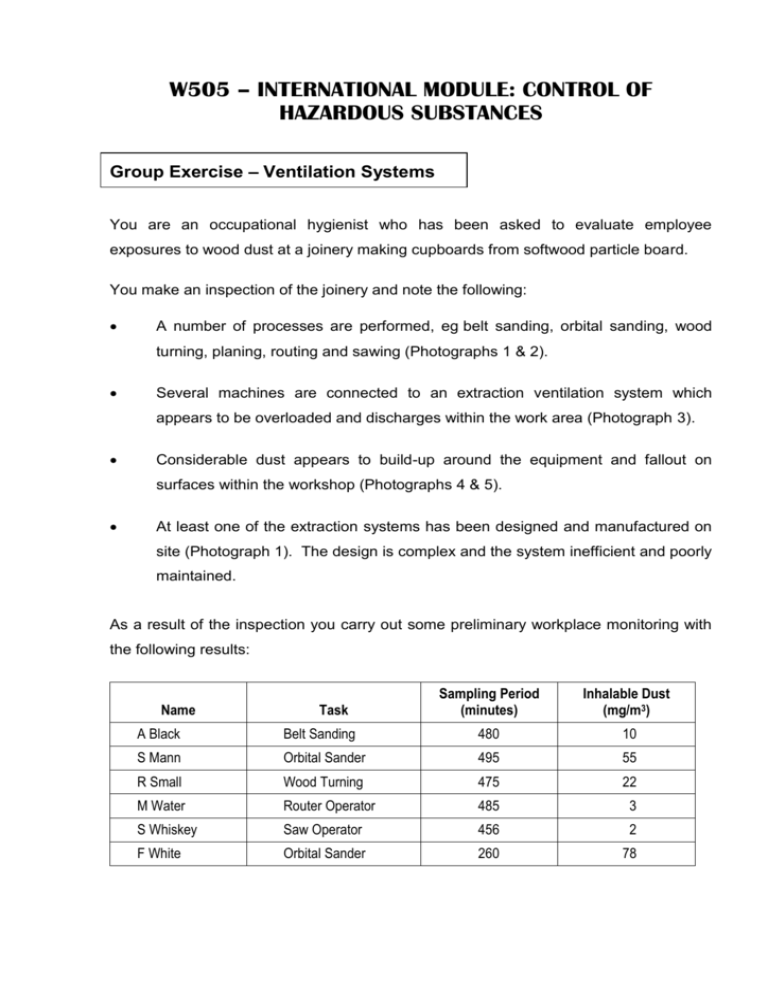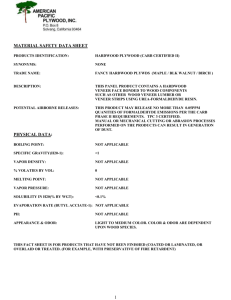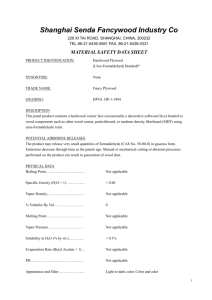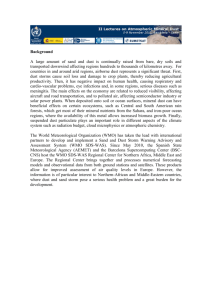Group Exercise Ventilation Systems
advertisement

W505 – INTERNATIONAL MODULE: CONTROL OF HAZARDOUS SUBSTANCES Group Exercise – Ventilation Systems You are an occupational hygienist who has been asked to evaluate employee exposures to wood dust at a joinery making cupboards from softwood particle board. You make an inspection of the joinery and note the following: A number of processes are performed, eg belt sanding, orbital sanding, wood turning, planing, routing and sawing (Photographs 1 & 2). Several machines are connected to an extraction ventilation system which appears to be overloaded and discharges within the work area (Photograph 3). Considerable dust appears to build-up around the equipment and fallout on surfaces within the workshop (Photographs 4 & 5). At least one of the extraction systems has been designed and manufactured on site (Photograph 1). The design is complex and the system inefficient and poorly maintained. As a result of the inspection you carry out some preliminary workplace monitoring with the following results: Name Task Sampling Period (minutes) Inhalable Dust (mg/m3) A Black Belt Sanding 480 10 S Mann Orbital Sander 495 55 R Small Wood Turning 475 22 M Water Router Operator 485 3 S Whiskey Saw Operator 456 2 F White Orbital Sander 260 78 2. During the work day the following peak readings were recorded in the breathing zone of the person operating the orbital sander using a TSI Dust Trak direct reading instrument. All results were recorded when sanding was taking place. 240 mg/m3 75 mg/m3 260 mg/m3 1 mg/m3 120 mg/m3 420 mg/m3 7 mg/m3 Note: The TSI Dust Trak instrument was calibrated to read inhalable dust Photograph 1 – Router Photograph 2 - Saw Photograph 3 – Extraction System Photograph 4 – Dust Build-up 3. Photograph 5 – Dust Build-up EXERCISE: Using the above information, prepare a LEV design proposal for the site management that would minimise the exposure levels of those workers considered at risk. Include in your proposal a schematic diagram of the system and indicate what type of collector hoods, face velocities and transport velocities you would need to use for the system to be effective. As part of the implementation strategy indicate how the system should be tested in the initial stages and long-term List any other factors that you would need to consider in your design proposal 4. SUPPLEMENTARY INFORMATION: Material Safety Data Sheet PRODUCT NAME: Particle Board USES: Construction of cabinets, furniture and as a general purpose building board PHYSICAL DESCRIPTION & PROPERTIES Appearance: Pressed boards of 9 – 33 mm thickness Odour: Newly cut surfaces may have a resin and pine odour COMPOSITION Chemical Name CAS Number Proportion Wood Particles (softwood) None >85% Urea Formaldehyde Resin 9011-05-6 <13% Melamine Urea Formaldehyde Resin 25036-13-9 <13% Paraffin Wax 8002-74-2 <2% Dust from this product contains: Softwood Dust >85% Cured Binder <15% HEALTH EFFECTS Acute (short term) Health Effects Swallowed: Unlikely under normal conditions. Swallowing the dust may cause abdominal discomfort. Eye: Wood dust and the resin may be irritating to the eyes resulting in redness and watering. Skin: Skin contact with wood dust and the resin, may result in skin itching and redness and dermatitis in some people. Inhaled: Inhalation of wood dust and the resin may be irritating to the nose, throat and lungs. 5. Chronic (long term) Health Effects Repeated exposures over many years to uncontrolled dusts increase the risk of nasal cavity cancer. Inhalation of wood dust may also increase the risk of lung fibrosis (scarring). There are also increased risks of respiratory and skin sensitisation from wood dust and resin in asthma and dermatitis respectively. Wood dust has been evaluated by the International Agency for Research on Cancer (IARC) as group 1, carcinogen to humans. Formaldehyde has been evaluated by the IARC as group 1, carcinogenic to humans and by the European Union (EU) as a Category 3 carcinogen (possibly carcinogenic). TOXICOLOGICAL & EPIDEMIOLOGICAL DATA Any health hazards associated with these products have been evaluated on the basis of the individual ingredients, and these hazards should be assumed to be additive. The hazards described in this document have been evaluated based on a threshold of 1.0% for all hazardous ingredients and 0.1% for all carcinogens. Acute Effects The dust, which may be generated during manual or mechanical cutting, drilling, sanding or other abrading processes, and the smoke generated by heating or laser cutting, may cause temporary irritation of the eyes and upper respiratory system. The symptoms are expected to subside after exposure has stopped and are not expected to cause any long-term effects. Allergic skin and lung reactions have been reported with exposure to various wood panels’ dusts due to the chemicals presented in wood and cured resin. These rashes resemble other allergic skin reactions caused by plants, and usually heal rapidly. Chronic Effects The risk of nasal cancer has been associated with wood dust exposure. In the 1960s, studies linking wood dust exposure in the furniture industry with nasal cancer were first 6. reported in England. The link was confirmed in several other European countries and furniture industries. The studies showing a link to nasal cancer have been primarily conducted in industries using hardwood. The International Agency for Research on Cancer (IARC) evaluated dusts from both hardwood and softwood in 1995 and concluded that: “There is sufficient evidence in humans for the carcinogenicity of wood dust. There is inadequate evidence in experimental animals for the carcinogenicity of wood dust. Wood dust is carcinogenic to humans (Group 1).” The IARC also evaluated formaldehyde in 19951 and concluded that: “There is limited evidence in humans for the carcinogenicity of formaldehyde: there is sufficient evidence in experimental animals for the carcinogenicity of formaldehyde; and that overall formaldehyde is probably carcinogenic to humans (Group 2A)”. The IARC again evaluated formaldehyde in June 20042 and concluded that “there are adequate data available from humans for an increased risk of nasopharyngeal cancer” and that formaldehyde should now be classified as Group 1, carcinogenic to humans. Whilst this wood panel product contains less than 0.01% free formaldehyde, people using the product may be exposed to low concentrations of formaldehyde if the boards are heated (as in laminating), are cut by laser cutting machines, and/or if dust particles come in contact with the moist mucous membranes lining the upper respiratory tract. Extensive literature searches and research carried out by independent occupational and environmental health specialists has not indicated any risks over and above those associated with wood dust without binder. This research includes the 1999 formaldehyde risk assessment carried out by US scientists in collaboration with the US EPA and Health Canada. The risk assessment concludes that if a non-smoking worker were exposed to 0.004 ppm of formaldehyde continuously for 80 years and also to 0.1 ppm for 40 years at work then the predicted additional risk of respiratory tract cancer would be 4.1 per 1,000,000,000. The controls needed for minimising the potential for formaldehyde exposure from this product will be the same as those for 1 IARC Monographs on the Evaluation of Carcinogenic Risks to Humans. Volume 62: Wood dust and formaldehyde. IARC, Lyon, France. 1995. 2 IARC Press Release No.153, 15 June 2004, IARC, Lyon, France. 7. control of dust exposures. These risk assessments and conclusions are in no way altered by the reclassification of formaldehyde to Group 1 by the IARC. Exposure Standards Softwood (as inhalable dust) = 1 mg/m3 Formaldehyde = 0.3 ppm Explosion Hazard Wood dust may ignite at temperatures greater than 204°C and at high concentrations in air (>60 mg/m3) may spontaneously explode. Note: This practical has been prepared from a mixture of factual and fictitious material and any resemblance to any situation or organisation is coincidental. The MSDS used in this exercise has been specifically prepared for this situation and should not be used for any other purpose.





